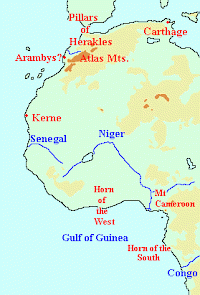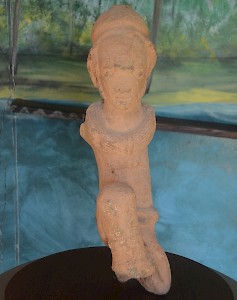Hanno the Navigator
In the first half of the sixth century BCE, the Carthaginian admiral Hanno made a long voyage along the African west coast. His logbook contains a description of a fully active volcano and the first known report about gorillas.

The eighteen lines of Hanno's artless account of his journey along the west coast of Africa (reportedly written on a Carthaginian temple wall but translated in Greek) are a unique document. This is the only known first-hand report on those regions before those of the Portuguese, which were written two thousand years later. It is the longest known text by a Punic author. Besides, Hanno has a fascinating story to tell: we visit a mysterious island, have to fight hostile natives, survive an erupting volcano, and encounter gorillas.
Probably, Hanno made his voyage on the outer sea in the first half of the sixth century BCE. He had orders to found several colonies on the Moroccan coast; having done so, he established a trading post on a small island off the Mauritanian coast. After completing the original mission, he ventured further south, making a reconnaissance expedition along the African coast until he reached modern Gabon, where he was forced to return because he was running out of supplies. There is some reason to doubt the truth of the latter statement, because the Roman encyclopedist Pliny the Elder says that Hanno circumnavigated Africa and reached the borders of Arabia.note
On his return, Hanno dedicated an inscription to one of the Carthaginian gods, in which he told what he had done. (It is possible that he was not the author. An irregularity in line 15 disappears when we accept the hypothesis that a scribe interviewed two sailors.) In the fifth century, someone translated this text into a rather mediocre Greek. It was not a complete rendering; several abridgments were made. The abridged translation was copied several times by Greek and Byzantine clerks.

At the moment, there are only two copies, dating back to the ninth and the fourteenth centuries. The first of these manuscripts is known as the Palatinus Graecus 398 and can be studied in the University Library of Heidelberg. The other text is the Vatopedinus 655; parts of it are in the British Museum in London and in the Bibliothèque Nationale in Paris.
Many scholars have tried to identify the places Hanno mentions. Nowadays, most puzzles - such as the question of the volcano called "Chariot of the Gods" - seem to be solved. In the commentary below, many toponyms are discussed. All places under discussion can be found in the 1998 edition of the Times Atlas of the world. Other texts related to Hanno's voyage are to be found below.